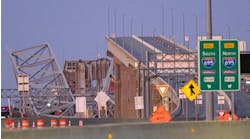Maine — famous for its lobster and home to author Stephen King— has 3,478 miles of coastline and over 32,000 miles of rivers and streams. The Presumpscot River begins in Sebago Lake and empties into Casco Bay before reaching the Atlantic Ocean.
Located near the river’s mouth, the Veranda Street Bridge carries up to 75,000 vehicles per day on busy I-295 across Veranda Street (Route 1) in Portland. The interstate is a central artery that connects Portland and points south with Falmouth, Freeport and other Casco Bay-area destinations in southern and mid-coastal Maine.
Thanks to a lot of pre-planning, public outreach, and project team coordination, the Maine Department of Transportation replaced this aging, deteriorated bridge in its entirety over one weekend. Upon completion of the replacement in April, the Veranda Street Bridge project became the largest, fastest, and most ambitious accelerated bridge construction (ABC) project in MaineDOT’s history.
According to Tim Cote, project manager at HNTB, the feasibility assessment confirmed conventional construction would require building a significant temporary bridge to maintain traffic duration construction and completing the work in four stages:
- Stage 1: Construction of temporary bridge
- Stage 2: Shift I-295 northbound traffic onto the temporary bridge. Demolish and replace the old northbound bridge.
- Stage 3: Leaving I-295 northbound traffic on the temporary bridge, shift I-295 southbound traffic onto the newly built northbound bridge. Demolish and replace the old southbound bridge.
- Stage 4: Shift I-295 northbound and southbound onto the new bridges. Demolish the temporary structure.
“The team was challenged to create a single set of contract documents that worked for the full range of ABC movement methods allowed by the contract documents,” Cote said. “A forward-thinking approach resulted in the development of a notional set of design criteria and details that accommodated the allowed movement systems with only minor adjustments to the details in the contract plans. This complicated dance of balancing design requirements and standards was completed successfully and yielded a single design solution that, with only minor changes to the layout of reinforcing steel, accommodated the use of SPMTs on the project.”
MaineDOT mimicked ABC’s overall simplicity by choosing an equally simple design for the new bridge. Instead of three spans, the new bridge would require only one shorter, jointless span, and the remaining area underneath the old span also was filled in and converted into embankments.
This simpler design saved time during the weekend-long replacement effort — when adhering to a strict schedule was crucial — and will make future maintenance easier and less costly. In addition, the new bridge is higher than the old one, reducing the risk of it being struck by over-height trucks and other vehicles.
Using ABC allowed the project team to build the upper portion of the new bridge on temporary supports in an acre-and-a-half area adjacent to the existing bridge. Simultaneously, supports for the new bridge were constructed underneath the existing bridge — all without impeding I-295 traffic overhead or placing workers in high-traffic zones on the existing span, keeping both motorists and workers safe.
MaineDOT chose to close the area to traffic during the weekend when the old bridge would be demolished, and the new bridge driven into place. While the closure necessitated much up-front planning, coordination, and community outreach, it created a much safer work zone and drastically reduced overall traffic impacts.
The Veranda Street project also encompassed vital improvements to ramps and adjacent roadways. Roadway configurations underneath and near the old bridge were outdated and confusing, leading to one of the highest crash rates in the state where the I-295 on-ramp and Veranda Street intersected. A new design provided two 11-foot-wide travel lanes and significantly simplified traffic patterns. R&B
Project Name: Veranda Steet Bridge Replacement
Project Location: Portland, Maine
Owners: Maine Department of Transportation
Designer: HNTB Corporation, Lead Designer
Contractors: Cianbro Corporation, Shaw Brothers Construction, Inc.
Cost: $21.7 million
Length: .3 miles
Completion Date: November 2022



